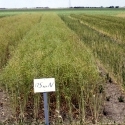06 Nov 2014
Nutrient Use Efficiency
Presented at the 2014 AFSA meeting
 Canola crops from Mount Arapiles
Canola crops from Mount Arapiles
Nutrient Performance Indicators:
The importance of farm scale assessments, linked to soil fertility, productivity, environmental impact and the adoption of grower best management practices.
• Efficient and effective use of plant nutrients is essential to meet global Sustainable Development Goals.
• To estimate broad scale nutrient use efficiency, partial nutrient balance (PNB) and partial factor productivity (PFP) indicators can be derived at a range of spatial and temporal scales and provide some intelligence on nutrient use.
• Partial factor productivity answers the question “How productive is this cropping system in comparison to its nutrient input?” It will, by definition, decline with increased nutrient inputs.
• Partial nutrient balance answers the question “How much nutrient is being taken out of the system relative to the amount supplied?” System PNB only indicates the fate of nutrients removed in harvested produce. It does not consider other transfer processes and so is not an indicator of nutrient loss to the environment.
• These indicators require good quality scalable (i.e., regional or local) data, clarification of the assumptions used and identification of the boundaries of the system assessed.
• The use of national or global indicators may mask important spatial variations among regions, farming systems, and farms, the level at which interventions will be applied. Farm level nutrient performance data are needed to develop appropriate interventions to improve nutrient performance.
• Trends over time in regional, catchment or farm scale indicators to gauge trends are preferable to once only broad scale assessments.
• Even though it presents challenges, mixed crop and livestock systems as well as cropping systems should be considered in the assessment of nutrient performance indicators.
• A single performance indicator is likely to be misleading in the assessment of the efficiency and effectiveness of nutrient management. To provide meaning, it is proposed that other essential indicators be included and they would consider:
- • Changes in soil nutrient levels or soil fertility.
• An assessment of the magnitude of the nutrient-limited gap between actual and achievable yield.
• Evidence of the adoption of nutrient best management practices such as the adoption of soil testing, farmer training, and/or farm record keeping, etc.
Additional Resources
NUE presentation AFSA Adelaide 2014Size: 3.62 MB




